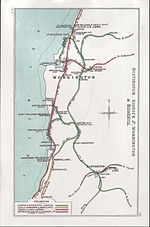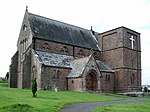Copperas Hill railway station

Copperas Hill railway station served the small clifftop community of Copperas Hill, south of Harrington in the former county of Cumberland, England, which is now part of Cumbria. A public passenger service called at the station between 2 June 1913 and September 1921, though unadvertised workmen's trains had started in April 1912 and continued until April 1929, after which all forms of passenger service ceased. By 1922 the service had settled down to three trains each way between Lowca and Workington Central, though, surprisingly in that age, trains had stopped calling at Copperas Hill in September 1921. There never was a public Sunday service.The station was on the Harrington and Lowca Light Railway which connected with the Cleator & Workington Junction Railway (CWJR) at Rosehill Junction a short distance north of Copperas Hill and south of Harrington Village. Workmen's services to and from Copperas Hill variously ran from Moss Bay Cart Siding, Maryport (during the First World War), Workington Central and Seaton (Cumbria). Public passenger trains ran to these last two only.
Excerpt from the Wikipedia article Copperas Hill railway station (License: CC BY-SA 3.0, Authors, Images).Copperas Hill railway station
Rose Hill,
Geographical coordinates (GPS) Address Nearby Places Show on map
Geographical coordinates (GPS)
| Latitude | Longitude |
|---|---|
| N 54.6042 ° | E -3.5688 ° |
Address
Rose Hill
CA14 5QL , Salterbeck
England, United Kingdom
Open on Google Maps







